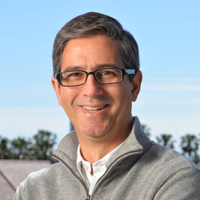
Juan J. Alonso
Vance D. and Arlene C. Coffman Professor
Department of Aeronautics & Astronautics
Stanford University
Plenary Title: Using Probabilistic CFD Methods for Aircraft Certification by Analysis
Abstract
The length of the flight certification phase of modern commercial transports and the staggering costs associated are motivating a strong interest in utilizing the result of high-fidelity simulations as an alternative to flight testing. For this to become a reality, the results of high-fidelity simulations must have the same level of confidence/uncertainty that is typically associated with flight tests. Unfortunately, the current state of the art only provides deterministic predictions of the derived quantities of interest, leaving little chance that the FAA or EASA would accept the results as proof of compliance. We must endow simulations with estimates of numerical errors and uncertainties. This talk discusses our efforts to develop probabilistic aerodynamic databases that can be consumed by 6-dof simulation techniques to provide both distributions and levels of confidence of the quantities of interest required. Two certification maneuvers of interest are discussed, the emergency descent and the pitch-recovery maneuvers, both of which pose significant challenges to state-of-the-art RANS predictions. Our hope is that methodologies of this sort can pave the way for more pervasive use of Certification by Analysis in the future transport fleet.
Biography: Juan J. Alonso is the Vance D. and Arlene C. Coffman Professor of Aeronautics and Astronautics at Stanford University. Prof. Alonso is the founder and director of the Aerospace Design Laboratory (ADL) where he specializes in the development of high-fidelity computational analysis and design methodologies to enable the creation of realizable and efficient aerospace systems. He is the author of over 200 technical publications on the topics of computational aircraft and spacecraft design, multi-disciplinary optimization, fundamental numerical methods, and high-performance parallel computing. During the period spanning 2006-09, Prof. Alonso was the Director of the NASA Fundamental Aeronautics Program in Washington, DC. In that position he was responsible for the entire portfolio of aerospace vehicle and vehicle technology research for the agency in the subsonic rotary wing, subsonic fixed wing, supersonic, and hypersonic regimes, with particular emphasis on the energy and fuel efficiency of the aviation enterprise and its environmental impact. He is the recipient of several AIAA Best Paper Awards, the NASA Exceptional Public Service Medal, the NASA ARMD Associate Administrator Award, and the AIAA Stanford Chapter Professor of the Year award (8 times). Prof. Alonso has served in the NASA Advisory Council, the Secretary of Transportation’s Future of Aviation Advisory Committee, the FAA Administrator’s Management Advisory Council, and as an Independent Expert in the ICAO/CAEP fuel burn, noise, and emissions technology goals evaluation. Prof. Alonso and the ADL are responsible for the development of the open-source SU2 analysis and design environment, intended for use by the worldwide community to advance the state-of-the-art in numerical optimization of fluid flows. Prof. Alonso earned his Ph.D. in Mechanical and Aerospace Engineering at Princeton University and his B.S. degree at the Massachusetts Institute of Technology.

Makoto Yamamoto
Professor, Department of Mechanical Engineering
Tokyo University of Science
Plenary Title: Multi-physics CFD simulation of particle deposition with a hybrid grid- and particle-based method
Abstract
Particle deposition occurs in a jet engine, when a jet engine is operated in a particulate environment like volcanic ash clouds. The ingested ash is melted in a combustion chamber and becomes a small droplet because the temperature exceeds the melting point of ash. Since turbine components are colder than the droplet, some droplets adhere and accrete on the surfaces. The particle deposition does not only leads to deterioration of the turbine performance, but also shorten the life time of the turbine. Therefore, the prediction and understanding of the particle deposition phenomena are of importance from the engineering viewpoint. The objectives of the present study are to model the particle deposition phenomenon with a hybrid grid- and particle-based method, and to investigate the particle deposition around the leading edge of a modeled high-pressure turbine vane. The finite difference method was used as the grid-based method to simulate the flow field, the E-MPS method was employed as the particle-based method to simulate the solidification of droplets, and these two methods were effectively coupled. In the presentation, the detail of numerical procedures will be explained, and then some typical results will be introduced.
Education: 1987 University of Tokyo, Graduate School of Engineering; 1988 Dr. of Engineering
Experience: 1987 Ishikawajima-Harima Heavy Industry Co. Ltd., Aeronautics and Aerospace Division; 1990-Present Tokyo University of Science, Depart. of Mechanical Engineering: 1990-1995, Lecturer; 1995-2004, Associate Professor; 2004-Present, Professor;
Positions Head at the Tokyo University of Science: 2009 – 2010 Dean of the Faculty of Engineering; 2011 – 2018 Head of the Faculty Development Center; 2014-2018 Vice President
Awards: 1995 Research Encourage Award, Japan Society of Mechanical Engineers (JSME); 2002 Distinguished Service Award, Gas Turbine Society of Japan (GTSJ); 2006 Fellow, Japan Society of Fluid Mechanics (JSFM); 2007 Distinguished Service Award, Japan Society of Mechanical Engineers (JSME); 2010 Fellow, Japan Society of Mechanical Engineers (JSME); 2010 Computational Mechanics Achievement Award, JSME Computational Mechanics Division; 2014 JACM Fellows Award, Japan Association for Computational Mechanics (JACM); 2015Computational Mechanics Award, JSME Computational Mechanics Division

Marie Oshima
Professor, Interfaculty Initiative in Information Studies
The Institute of Industrial Science, The University of Tokyo
Plenary Title: Challenges towards clinical applications: Computational hemodynamics for cerebral circulation
Abstract
A reduced-order simulation based 1D-0D model has been developed for the entire circulatory system combined with the patient-specific data in order to examine the effects of carotid artery stenting (CAS) on cerebrovascular circulation. The present simulation system was applied to investigate the blood flow to predict the cerebral hyperperfusion syndrome (CHS).
Biography: Prof. Oshima's main research area has been computational hemodynamics, particularly medical-image based modeling and blood flow simulation for cardiovascular diseases such as atherosclerosis. She has been also working on flow visualization and measurements using micro PIV (Particle Image Velocimetry) technique for blood flow related problems. She has been the director of the Office for the Next Generation at IIS since 2011, working on STEAM (Science, Technology, Engineering, Arts, and Mathematics) education for the young generation. In 2017 Prof. Oshima was the president of the Japan Society of Mechanical Engineers.
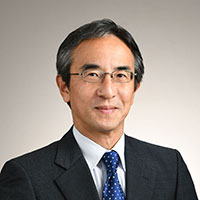
Masafumi Kawai
Chief Engineer
Technology & Intelligence Integration
IHI Corporation
Title: Development of Floating Type Ocean Current Turbine for Kuroshio Current
Abstract
The Kuroshio Current flowing near coastal areas of Japan is one of the strongest ocean currents on the globe, and IHI is developing a floating type ocean current turbine system to utilize its power as promising renewable energy. We have fabricated a novel 100 kW turbine demonstration machine with turbine blade diameter of 11 m. The demonstration test was conducted in August 2017 under the real Kuroshio Current. The test went successfully and we have obtained a lot of data for future development. Engineering features of our system, highlights of the test, and future scenario of development and commercialization of the ocean current turbine system will be presented.
Biography: Dr. Masafumi Kawai finished Master Course of Applied Mechanics in Kyushu University in 1983. Then he joined IHI as a research scientist of fluid engineering. He received Ph.D. from Kyushu University in 2008. He has been working as the Chief Engineer in IHI Technology & Intelligence Integration (former Corporate R & D) since 2013. He served as the Chairman of the JSME FED in 2014. He is now serving as the Chairman of the Kanto Branch of JSME. He has been the member of the Working Group for Promotion of Research & Development for Priority Issues on the Post-K Computer, Ministry of Education, Culture, Sports, Science and Technology since 2015.
His main R & D activity is the solution of various flow-related problems encountered in the development, design and operation stages in the heavy industry.
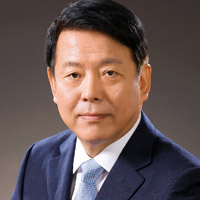
Professor Kwang-Yong Kim
Inha Fellow Professor
Department of Mechanical Engineering
Inha University, Korea
Winner of the 2018 KSME Research Excellence Award in Fluids Engineering
Plenary Title: Analysis and Design of Membraneless Microfluidic Fuel Cells
Abstract
Membraneless microfluidic fuel cells (MMFCs) employ two parallel laminar flow streams of reactants in a microchannel. MMFCs considerably simplify the structural design of micro fuel cells by removing the proton exchange membrane, which helps to achieve miniaturization and motivates researchers to put efforts into on-chip integration. However, MMFCs have a problem of relatively low maximum power density due to the increased ohmic loss caused by the removal of the membrane. Therefore, a current issue of MMFC research is to enhance the performance of MMFCs by modifying the geometries of the microchannel and electrodes. In the present work, a fully coupled three-dimensional numerical model is developed to evaluate the MMFC performance. Various configurations of microchannel and electrodes are proposed to enhance the MMFC performance such as power and current densities. The performance is successfully enhanced with tapered channel and electrodes, multiple compartments of microchannel cross section, inlets located midway along the microchannel, multiple inlets, and narrow and wide bridge-shaped microchannels.
Biography: Kwang-Yong Kim received his B.S. degree from Seoul National University in 1978, and his M.S. and Ph.D. degrees from the Korea Advanced Institute of Science and Technology (KAIST), Korea, in 1981 and 1987, respectively. He is currently a Dean of Engineering College and an Inha Fellow Professor in the Department of Mechanical Engineering of Inha University, Incheon, Korea. He is also a co-editor-in-chief of the International Journal of Fluid Machinery and Systems and an associate editor of ASME Journal of Fluids Engineering. He served as the editor-in-chief of the Transactions of Korean Society of Mechanical Engineers, the president of Korean Society for Fluid Machinery, and the chairman of the Asian Fluid Machinery Committee. He is a fellow of the Korean Academy of Science and Technology, a member of National Academy of Engineering of Korea, a fellow of the American Society of Mechanical Engineers (ASME), an associate fellow of the American Institute of Aeronautics and Astronautics (AIAA), and a recipient of the Order of Science and Technology Merit, “Doyak Medal” from Republic of Korea. Prof. Kim is interested in the analysis and design of fluid machinery, microfluidic fuel cells, micro mixers, micro heat sinks, heat-transfer augmentation devices, etc. He has published 365 peer-reviewed journal papers, and presented 541 papers at international/domestic conferences.
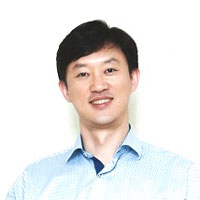
Professor Simon Song
Department of Mechanical Engineering
Hanyang University, Korea
Winner of the 2019 KSME Nam-Heon Academic Award in Fluids Engineering
Plenary Title: Wall Shear Stress of Hemodynamic Flow Measured by 4D Flow MRI (toward its accuracy estimation and improvement)
Abstract
Wall shear stress (WSS) exerted on a blood vessel is one of the key parameters associated with cardiovascular diseases. For example, the magnitude and temporal oscillation of WSS is known to be correlated with atherosclerosis, aortic dilatation and vascular remodeling. To measure WSS in in vivo studies 4D flow MRI (or Magnetic Resonance Velocimetry) has been utilized in clinical research because it is the most advanced flow visualization modality capable of visualizing an opaque internal flow with complex geometry and providing time-resolved, 3-componen ts of velocity vector in 3 dimensional space. However, the accuracy of WSS estimation is controversial in clinical research because 4D flow MRI has relatively low spatial resolution and the true WSS value is generally unknown in in vivo study. Recently we have studied a novel and facile method to assess and improve WSS accuracy in 4D flow MRI measurements. In this talk we will present the results including (1) novel and facile criterion called Reynolds resolution to assess the accuracy of WSS estimated from 4D flow MRI without knowing the true WSS, (2) custom-made RF coil for increasing spatial resolution (3) improvement of WSS accuracy by considering partial volume effects of 4D flow MRI measurements, and (4) applications of 4D flow MRI to carotid artery flows and porous media flow.
Biography: Prof. Song is interested in the development of flow visualization technique for a variety of flows including patient-specific hemodynamic flows, complicated geometric flows such as porous media, and microscale flows.
Recently, he has studied hemodynamic characteristics related to cardiovascular diseases using a versatile flow visualization technique, 4D flow MRI, to investigate. Additionally he has been interested in the engineering application of this technology.
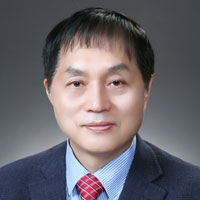
Professor Sang Joon Lee
Department of Mechanical Engineering
Pohang University of Science and Technology, Korea
Winner of the 2019 KSME Research Excellence Award in Fluids Engineering
Plenary Title: Expedition to flow phenomena in vascular plants and development of biomimetic technologies
Abstract
The most important problems facing human over the next 50 years include energy, water, food, environment and diseases, etc. These are closely associated with biofluid flow phenomena in plants. In addition, biological flows are vital for the conservation of life and indispensable commodity of living organisms. Morphological structures and biological flow phenomena of plants have been evolved through long history. To challenge the basic biophysics of several flow phenomena in plants and reveal hidden secrets of nature, a high-resolution X-ray imaging technique was employed under in vivo conditions. The biological flows referred in this talk include sap flows in xylem vessels of vascular plants (rice, maize, Arabidopsis and mangrove) and regulation of flows through plant membranes. To measure instantaneous whole velocity fields of opaque sap flows, gold nanoparticles were used as tracer particles. Based on detailed understanding about these biofluid flow phenomena, several creative nature-inspired creative biomimetic technologies were developed for practical applications in microfluidics, sustainable energy, and water purification to improve the quality of human life.
Biography: Professor Sang Joon Lee joined POSTECH as a faculty member on Jan of 1987. He is an international leader in bio-fluid flows, biomimicry and experimental fluid dynamics. He was elected as an APS (American Physics Society) fellow, for his contribution to experimental fluid mechanics, especially in the development of advanced flow visualization techniques and various successful applications to biofluid flows, microfluidics and turbulent shear flows. Prof. Lee's achievement was recognized by the National Medal of Science (2017) and he was elected to be the POSTECH University Professor since 2017.
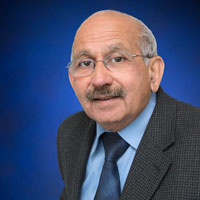
Upendra Singh Rohatgi
Senior Scientist
Brookhaven National Laboratory
Upton, New York, USA
Winner of the 2019 ASME Freeman Scholar Award
Plenary Title: Verification, Validation, Scaling and Uncertainty Quantification for Thermal-Hydraulics Applications
Abstract
General purpose analytical tools such as system codes and CFD codes are being developed for fluids engineering applications. There a need to quantify the accuracy of predictions for each application. These codes consist of formulation, constitutive relationships and numerics. Each of these elements contribute to the uncertainty in the prediction for specific application. Codes must be validated for each potential application with relevant single phenomenon tests (Separate Effects Test) and multi-phenomena tests (Integral Effects Test). All the uncertainties must be aggregated to provide a statement of accuracy in the predicted quantity of interest. A large of body work for verification, validation, scaling and uncertainty quantification for predictive tools and models is available in the literature. This presentation will describe the approaches for verification. It will show a systematic approach to identify and rank phenomena with respect to their impact on predicted results. The models for the important phenomena in the codes will require validation. The validation is performed with actual tests that are specific to the application and have significant impact on the predicted results. Impact of mismatch of validation domain and application domain will be addressed. The selected tests should represent the application and have minimum scale distortion. The final step is to quantify the accuracy of prediction.
Biography: Dr. Rohatgi is a senior mechanical engineer and on scientific staff of Brookhaven National laboratory since 1975. He has contributed to the development of computer code for nuclear reactor safety, validation and uncertainty quantifications, and review of safety analyses submissions from the nuclear industry for US Nuclear Regulatory Commission. In parallel, he has implemented non-proliferation programs through engagement of weapon scientists from Former Soviet Countries (FSU) in civilian technology development in collaboration with US Industries for the Departments of Energy and State. Currently, he is developing validation guidelines and education material for training of graduate students in verification, validation uncertainty quantification methods for Department of Energy and Nuclear Energy Agency of OECD-Paris. In addition, he is developing a relational data base for organization and preservation of international thermal-hydraulics tests at NEA-OECD. Dr. Rohatgi has been an active member of ASME since 1970 and was elected an ASME Fellow in 1997. He is the holder of many ASME and other awards.
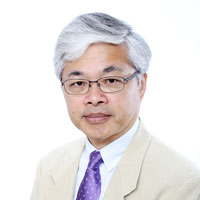
Akira Goto
Technical Superintendent
Technologies, R&D Division
Ebara Corporation, Kanagawa, Japan
Winner of the 2019 ASME Henry R. Worthington Medal
Plenary Title: Past, Present and Future of Three-Dimensional Flow Control in Pumping Machinery from Perspective of a Researcher in Industry
Abstract
The current fluid-dynamic design process of pumping machinery has been greatly enhanced by CFD and the digitization of design processes. However, the impeller / diffuser blade design still relies heavily on empirical equations and empiricism, which remain as serious bottlenecks for making breakthrough designs. The use of numerical optimization may be the solution, but it is not so straightforward due to the large number of design variables needed to define complex 3-D blade shapes and strong 3-D internal flow interactions. The challenges to this problem over the years are introduced in this presentation, some of which include: systematic control of complex secondary flows in flow passages using 3D inverse design method, trade-off design of performance characteristics of mixed-flow pump stages by combining inverse design method with numerical optimization using evolutionary algorithm, on-going activities on multi-disciplinary optimization and 3-D flow control, etc. Finally, the concept of industry-academia-government collaboration, which helps to breakthrough real-world problems in industry, is presented with some examples.
Biography: Dr. Akira Goto received a Doctorate degree at University of Tokyo in 1981 and then joined Ebara Corporation, where he conducted research on fluid machinery including pumps, fans, compressors, and hydraulic turbines. He was a Visiting Scholar at Whittle Laboratory, University of Cambridge (1988-1990), Board member at Ebara Research Company Ltd. (2002-2009), and Officer at Ebara Corporation (2006-2017).
He has been engaged in R&D on internal flow measurements, CFD, active/passive control of stall phenomena in pumps and fans, application of inverse design methodology, and numerical optimization for fluid-dynamic design of turbomachinery components. Dr. Goto is now guiding the developments of fundamental technologies for all major technical fields related to fluid machinery business at Ebara Corporation. He is the Honorary Members of the Visualization Society of Japan, the Japan Society of Mechanical Engineers (JSME), and the Turbomachinery Society of Japan (TSJ). He was the associate editor of the ASME JFE (2004-2007) and the Vice Chair at the AJK 2011. He is the holder of many awards from JSME and TSJ (1984-2018) and also the winner of the Fluid Machinery Design Award from Fluid Engineering Division of ASME (2016).